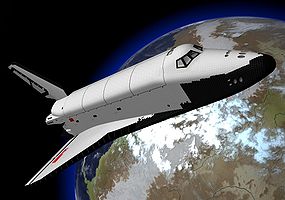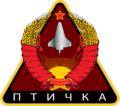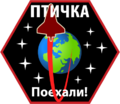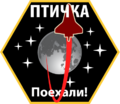Difference between revisions of "Ptichka"
m |
(significant revamp of character biography and quirks/trivia section, changed Stories links to AO3 archive from wiki archive.) |
||
| Line 3: | Line 3: | ||
|shipimage = Ptichka.jpg | |shipimage = Ptichka.jpg | ||
|caption = Ptichka in orbit of [[Gallifrey]], 2nd [[Tau Ceti]] Expedition, 2014. | |caption = Ptichka in orbit of [[Gallifrey]], 2nd [[Tau Ceti]] Expedition, 2014. | ||
| − | |hull = | + | |hull = [[Wikipedia:Buran|Buran]]-class Space Shuttle Orbiter |
|length = 36.37m / 119′ 4" | |length = 36.37m / 119′ 4" | ||
|width = 23.92m / 78′ 6" (wingspan) | |width = 23.92m / 78′ 6" (wingspan) | ||
| Line 11: | Line 11: | ||
|driverating = max velocity 0.1c | |driverating = max velocity 0.1c | ||
|weapons = | |weapons = | ||
| − | |manufacturer = | + | |manufacturer = NPO Molniya |
| − | |owner = | + | |owner = Order of Saint Grimace |
| − | |flag = | + | |flag = |
| − | |faction = [[Soviet | + | |faction = [[Sozvezdie Soviet]] |
|registry = N230WT (FAA)<br/> WTF023 ([[Port Phobos]]) | |registry = N230WT (FAA)<br/> WTF023 ([[Port Phobos]]) | ||
|datelaunched = 12 October, 2008 | |datelaunched = 12 October, 2008 | ||
| − | |purpose = | + | |purpose = Flagship, Red Banner Fleet<br/> Interstellar explorer |
| − | |crew = [[ | + | |crew = [[Malaclypse Fnord]], CDR<br/> [[Sora Hasegawa]], ENG/PLT |
|supcrew = Ptichka, SYSOP | |supcrew = Ptichka, SYSOP | ||
|auxvehicles = | |auxvehicles = | ||
|status = '''Active''' | |status = '''Active''' | ||
}} | }} | ||
| + | {{quote|Rise again.|20px}} | ||
| + | |||
== History == | == History == | ||
| + | Originally built in 1986 by the Soviet Union, the ''Buran''-class space shuttle orbiter 1.02 was part of an ambitious program to match the American Space Transportation System pound-for-pound in reusable spaceflight. The program was largely a Pyrrhic success; the first flight of an unmanned ''Buran'' in 1988 proved the concept viable, but coming at the tail end of the Soviet Union’s existence and with less logical purpose than the American program, Buran was quietly shut down shortly after the first flight and the program cancelled by 1993. | ||
| + | |||
| + | Spaceframe 1.02, originally planned to be the second orbiter to fly unmanned test missions, was abandoned in a mostly-complete state at the close of the program along with the rest of the ''Buran'' flight hardware. The destruction of the only flight-certified vehicle in a 2002 hangar collapse left 1.02 as the only remotely viable ''Buran'' vehicle left in the world. Despite this, the craft continued to languish in a Kazakhstan hangar until 2007, when the handwavium age began and the American-Canadian group known as the [[Sozvezdie Soviet|Order of Saint Grimace]] took an interest in the vehicle. | ||
| + | |||
| + | The Order purchased 1.02—at this point known as ''Ptichka'' (“Little Bird” or “Birdy”) by old Baikonur hands—and had it shipped from the Kazakh steppes to the United States where they began an intensive restoration and handwavium treatment, planning to bring the old shuttle to flight readiness. In the process of handwaving the ship an artificial intelligence sparked in the melange of old Russian electronics and modern computing hardware installed on the flight deck. This AI, Ptichka, was adopted by the Order as one of the gang. | ||
| + | |||
| + | The Order of Saint Grimace’s abrupt departure from Earth in 2008 changed quite a few plans. ''Ptichka'' found herself a free agent in the rapidly-evolving Fenspace frontier, and her crew (renaming themselves the Soviet Air Force in honor of their ship) decided to get in on the ground floor in the space-exploration business. ''Ptichka'' is credited with the first manned landing on the planet [[Mercury]], as well as the moons [[Titan]] and [[Triton]] and multiple interstellar firsts including first approach to the [[Epsilon Indi]] and [[Tau Ceti]] systems. | ||
| + | |||
| + | During the [[Boskone War]] ''Ptichka'' served as part of [[Great Justice]] in a convoy escort role; while not specifically a warship Ptichka’s cargo bay could hold a decent number of multirole missiles. Her most infamous wartime role was a [http://archiveofourown.org/works/1038094 2012 incident] when she was disabled on approach to Mars while carrying Great Justice commander [[Haruhi Suzumiya]] and her staff. Despite total drive failure ''Ptichka'' was able to land safely on the Martian desert south of Utopia Planitia. Shortly after this ''Ptichka'' was rotated out of combat service and returned to interstellar exploration, serving on the First [[Delta Pavonis]] Expedition as a first-down explorer. | ||
| + | |||
| + | During the 2016 reorganization of the Soviet Air Force Ptichka was officially promoted to flagship of the Red Banner Fleet, a position she has continued to hold through the annexation by the [[United Federation of Planets]]. Once abandoned in a shed in the desert, today Fleet Captain P. S. Lozino-Lozinskaya is a fixture of extrasolar science and exploration, one of several real world exemplars held up by Starfleet cadets as the “best of the best.” | ||
| − | ''Ptichka'' is | + | == Handwavium Quirks/Abilities == |
| + | ''Ptichka'' is a first-generation handwavium spacecraft and therefore has a fair number of quirks. The most obvious one is her inability to vocalize in human language: Ptichka “speaks” in birdsong and only in birdsong. Text subtitling on available displays allows neophytes to understand her, and long-term crew eventually learn the language—which might very well be a handwavium ability, though nobody’s put that to the test. The second-most obvious quirk involves her interior décor: originally clad in plain white beta cloth, the crew cabin has slowly but surely been taken over by ornate reds and gold wallpaper similar to the baroque nightmare found in New York’s [http://www.russiantearoomnyc.com/gallery Russian Tea Room]. Anything left on the cabin walls for too long will get absorbed by the décor. | ||
| − | + | The most significant of ''Ptichka''’s less-obvious quirks is her Beucephelus complex. Anyone not on a very short list of people who touch her controls will get a nasty response from the onboard security system. The defining characteristic of who gets to fly Ptichka seems to be who she considers family. So far only the original Order of Saint Grimace and a handful of newcomers have managed to make the cut; all others get shocks from mild to “fucking ow.” | |
| − | ''Ptichka'' | + | === Remote Avatars === |
| + | ''Ptichka'' is a liveship, and one of sufficient size and bulk that interacting on a human scale can be difficult at best, impossible at worst. Internet access—as an AI, Ptichka can use digital communication like any other computer intelligence—provides a bit of a buffer but sometimes physical access is required or desired. In pursuit of this, Ptichka has commissioned a series of small drone units to allow her to move about in standard-sized spaces. | ||
| − | + | '''Daily Use:''' The drone Ptichka prefers for daily use resembles her cyberspace avatar, a large white raven with black wings. The drone’s body structure has been modified to give Ptichka working “fingers” on the wings as well as opposable digits on the feet, allowing her to use tools and generally give her more freedom of movement than a simple bird avatar would. This form can be seen flying over Korolevgrad whenever Ptichka is in dock, as well as in and around Utopia Planitia when the flagship’s duties require her at the Federation capitol. | |
| − | + | '''Mess Dress:''' Used only for special occasions, the “mess” drone is a [[Wikipedia:White-bellied_sea_eagle|white-bellied sea eagle]] with similar modifications as the raven drone. Ptichka generally pulls this one out for official state functions, medal ceremonies and other events where the Soviet is trying to put their best foot forward. | |
| − | + | '''Ground Combat:''' Ptichka, as a spacecraft, is not expected to engage in ground actions. The purpose of this drone seems to be a combination of boredom on Ptichka’s part and cyberneticist [[Sora Hasegawa]]’s love of an interesting challenge. The result is this unique combat drone, an ''[[Wikipedia:Utahraptor|Utahraptor ostrommaysorum]]'' in Ptichka’s distinctive black and white coloring, complete with all the sharp teeth and claws ''Utahraptor'' is famous for. So far this drone hasn’t seen active use—it’s a bit cumbersome to keep in ''Ptichka''’s cargo hold, and the likelihood of Ptichka being in dire need of such a drone is fairly low. It does however get some use within Korolevgrad city limits, especially when the town theater is running a Jurassic Park retrospective. | |
| − | + | ||
| − | + | ||
| − | + | ||
| − | == | + | == Random Facts & Personal Data == |
| + | * Ptichka is one of the four matriarchs of the extended [[OV-200|Faget family]] of space shuttle shipminds. While not the oldest in terms of hull construction, as the one with the longest “awake” running time she tends to be first-among-equals, or second-among-equals behind [[Discovery]]. | ||
| + | * Has a running correspondence with [[Lun Alekseeva]] on the merits of anarcho-communism versus technosocialism. Neither one is convinced by the other’s arguments—yet—but some tactical ideas are getting crossover. | ||
| + | * Was ''so crushed'' to find out Neal Peart was an Objectivist it wasn’t funny, but then was ''so happy'' when he renounced it. | ||
| + | * Ptichka’s Best Moment Forever And Ever: Hosting Neil deGrasse Tyson for the location shoot for his 2016 Cosmos series. | ||
| + | * Ptichka’s Second-Best Moment Forever And Ever: “Sneaking” onto the Top Gear test track during filming of one of the Star-In-A-Reasonably-Priced-Car segments. | ||
| − | + | ''Fandoms: Stanislaw Lem, Arthur C. Clarke, Eclipse Phase, Prog-Rock, Stan Rogers, Star Trek, Raumpatrouille Orion, The Culture, Jurassic Park'' | |
== Stories == | == Stories == | ||
| Line 48: | Line 65: | ||
''Ptichka'' is featured in the following stories: | ''Ptichka'' is featured in the following stories: | ||
| − | + | * [http://archiveofourown.org/works/1038211 The Legend of SOS-Con] | |
| − | * [ | + | * [http://archiveofourown.org/works/1039578 With Liberty And Great Justice...] |
| − | + | * [http://archiveofourown.org/works/1038094 A Hard Rain's Gonna Fall] | |
| − | * [ | + | * [http://archiveofourown.org/works/1039619 Into the Great Wide Open] |
| − | * [ | + | * [http://archiveofourown.org/works/1032163 Bootup, a Fable for Space Shuttles] |
| − | * [ | + | * [http://archiveofourown.org/works/1222807 Candle in the Dark] |
| − | * [ | + | |
==Related Images== | ==Related Images== | ||
Latest revision as of 15:48, 16 August 2015
| USSR Ptichka | |
 Ptichka in orbit of Gallifrey, 2nd Tau Ceti Expedition, 2014. | |
| Spacecraft Characteristics | |
|---|---|
| Base Hull | Buran-class Space Shuttle Orbiter |
| Length | 36.37m / 119′ 4" |
| Width | 23.92m / 78′ 6" (wingspan) |
| Height | 16.35m / 53′ 8" (height on gear) |
| Mass | 75,000 kg / 165,347 lbs. |
| Drive Type | Pitch Field reactionless thrusters |
| Drive Rating | max velocity 0.1c |
| Primary Manufacturer | NPO Molniya |
| Owner | Order of Saint Grimace |
| Faction | Sozvezdie Soviet |
| Registry Number | N230WT (FAA) WTF023 (Port Phobos) |
| Launched | 12 October, 2008 |
| Purpose | Flagship, Red Banner Fleet Interstellar explorer |
| Primary Crew | Malaclypse Fnord, CDR Sora Hasegawa, ENG/PLT |
| Other Crew | Ptichka, SYSOP |
| Operational Status | Active |
| “ | Rise again. | ” |
Contents
History
Originally built in 1986 by the Soviet Union, the Buran-class space shuttle orbiter 1.02 was part of an ambitious program to match the American Space Transportation System pound-for-pound in reusable spaceflight. The program was largely a Pyrrhic success; the first flight of an unmanned Buran in 1988 proved the concept viable, but coming at the tail end of the Soviet Union’s existence and with less logical purpose than the American program, Buran was quietly shut down shortly after the first flight and the program cancelled by 1993.
Spaceframe 1.02, originally planned to be the second orbiter to fly unmanned test missions, was abandoned in a mostly-complete state at the close of the program along with the rest of the Buran flight hardware. The destruction of the only flight-certified vehicle in a 2002 hangar collapse left 1.02 as the only remotely viable Buran vehicle left in the world. Despite this, the craft continued to languish in a Kazakhstan hangar until 2007, when the handwavium age began and the American-Canadian group known as the Order of Saint Grimace took an interest in the vehicle.
The Order purchased 1.02—at this point known as Ptichka (“Little Bird” or “Birdy”) by old Baikonur hands—and had it shipped from the Kazakh steppes to the United States where they began an intensive restoration and handwavium treatment, planning to bring the old shuttle to flight readiness. In the process of handwaving the ship an artificial intelligence sparked in the melange of old Russian electronics and modern computing hardware installed on the flight deck. This AI, Ptichka, was adopted by the Order as one of the gang.
The Order of Saint Grimace’s abrupt departure from Earth in 2008 changed quite a few plans. Ptichka found herself a free agent in the rapidly-evolving Fenspace frontier, and her crew (renaming themselves the Soviet Air Force in honor of their ship) decided to get in on the ground floor in the space-exploration business. Ptichka is credited with the first manned landing on the planet Mercury, as well as the moons Titan and Triton and multiple interstellar firsts including first approach to the Epsilon Indi and Tau Ceti systems.
During the Boskone War Ptichka served as part of Great Justice in a convoy escort role; while not specifically a warship Ptichka’s cargo bay could hold a decent number of multirole missiles. Her most infamous wartime role was a 2012 incident when she was disabled on approach to Mars while carrying Great Justice commander Haruhi Suzumiya and her staff. Despite total drive failure Ptichka was able to land safely on the Martian desert south of Utopia Planitia. Shortly after this Ptichka was rotated out of combat service and returned to interstellar exploration, serving on the First Delta Pavonis Expedition as a first-down explorer.
During the 2016 reorganization of the Soviet Air Force Ptichka was officially promoted to flagship of the Red Banner Fleet, a position she has continued to hold through the annexation by the United Federation of Planets. Once abandoned in a shed in the desert, today Fleet Captain P. S. Lozino-Lozinskaya is a fixture of extrasolar science and exploration, one of several real world exemplars held up by Starfleet cadets as the “best of the best.”
Handwavium Quirks/Abilities
Ptichka is a first-generation handwavium spacecraft and therefore has a fair number of quirks. The most obvious one is her inability to vocalize in human language: Ptichka “speaks” in birdsong and only in birdsong. Text subtitling on available displays allows neophytes to understand her, and long-term crew eventually learn the language—which might very well be a handwavium ability, though nobody’s put that to the test. The second-most obvious quirk involves her interior décor: originally clad in plain white beta cloth, the crew cabin has slowly but surely been taken over by ornate reds and gold wallpaper similar to the baroque nightmare found in New York’s Russian Tea Room. Anything left on the cabin walls for too long will get absorbed by the décor.
The most significant of Ptichka’s less-obvious quirks is her Beucephelus complex. Anyone not on a very short list of people who touch her controls will get a nasty response from the onboard security system. The defining characteristic of who gets to fly Ptichka seems to be who she considers family. So far only the original Order of Saint Grimace and a handful of newcomers have managed to make the cut; all others get shocks from mild to “fucking ow.”
Remote Avatars
Ptichka is a liveship, and one of sufficient size and bulk that interacting on a human scale can be difficult at best, impossible at worst. Internet access—as an AI, Ptichka can use digital communication like any other computer intelligence—provides a bit of a buffer but sometimes physical access is required or desired. In pursuit of this, Ptichka has commissioned a series of small drone units to allow her to move about in standard-sized spaces.
Daily Use: The drone Ptichka prefers for daily use resembles her cyberspace avatar, a large white raven with black wings. The drone’s body structure has been modified to give Ptichka working “fingers” on the wings as well as opposable digits on the feet, allowing her to use tools and generally give her more freedom of movement than a simple bird avatar would. This form can be seen flying over Korolevgrad whenever Ptichka is in dock, as well as in and around Utopia Planitia when the flagship’s duties require her at the Federation capitol.
Mess Dress: Used only for special occasions, the “mess” drone is a white-bellied sea eagle with similar modifications as the raven drone. Ptichka generally pulls this one out for official state functions, medal ceremonies and other events where the Soviet is trying to put their best foot forward.
Ground Combat: Ptichka, as a spacecraft, is not expected to engage in ground actions. The purpose of this drone seems to be a combination of boredom on Ptichka’s part and cyberneticist Sora Hasegawa’s love of an interesting challenge. The result is this unique combat drone, an Utahraptor ostrommaysorum in Ptichka’s distinctive black and white coloring, complete with all the sharp teeth and claws Utahraptor is famous for. So far this drone hasn’t seen active use—it’s a bit cumbersome to keep in Ptichka’s cargo hold, and the likelihood of Ptichka being in dire need of such a drone is fairly low. It does however get some use within Korolevgrad city limits, especially when the town theater is running a Jurassic Park retrospective.
Random Facts & Personal Data
- Ptichka is one of the four matriarchs of the extended Faget family of space shuttle shipminds. While not the oldest in terms of hull construction, as the one with the longest “awake” running time she tends to be first-among-equals, or second-among-equals behind Discovery.
- Has a running correspondence with Lun Alekseeva on the merits of anarcho-communism versus technosocialism. Neither one is convinced by the other’s arguments—yet—but some tactical ideas are getting crossover.
- Was so crushed to find out Neal Peart was an Objectivist it wasn’t funny, but then was so happy when he renounced it.
- Ptichka’s Best Moment Forever And Ever: Hosting Neil deGrasse Tyson for the location shoot for his 2016 Cosmos series.
- Ptichka’s Second-Best Moment Forever And Ever: “Sneaking” onto the Top Gear test track during filming of one of the Star-In-A-Reasonably-Priced-Car segments.
Fandoms: Stanislaw Lem, Arthur C. Clarke, Eclipse Phase, Prog-Rock, Stan Rogers, Star Trek, Raumpatrouille Orion, The Culture, Jurassic Park
Stories
Ptichka is featured in the following stories:
- The Legend of SOS-Con
- With Liberty And Great Justice...
- A Hard Rain's Gonna Fall
- Into the Great Wide Open
- Bootup, a Fable for Space Shuttles
- Candle in the Dark
Related Images
Semi-official Artemis Foundation ship emblem.
| ||||||||||||||||
| |||||||||||||||||||






